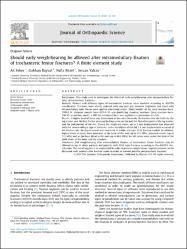| dc.contributor.author | Şeker, Ali | |
| dc.contributor.author | Baysal, Gökhan | |
| dc.contributor.author | Bilsel, Nafız | |
| dc.contributor.author | Yalçın, Sercan | |
| dc.date.accessioned | 10.07.201910:49:13 | |
| dc.date.accessioned | 2019-07-10T19:35:40Z | |
| dc.date.available | 10.07.201910:49:14 | |
| dc.date.available | 2019-07-10T19:35:40Z | |
| dc.date.issued | 2020 | en_US |
| dc.identifier.citation | Şeker, A., Baysal, G., Bilsel, N. ve Yalçın, S. (2020). Should early weightbearing be allowed after intramedullary fixation of trochanteric femur fractures? A finite element study. Journal of Orthopaedic Science, 25(1), 132-138. https://dx.doi.org/10.1016/j.jos.2019.02.011 | en_US |
| dc.identifier.issn | 0949-2658 | |
| dc.identifier.issn | 1436-2023 | |
| dc.identifier.uri | https://hdl.handle.net/20.500.12511/892 | |
| dc.identifier.uri | https://dx.doi.org/10.1016/j.jos.2019.02.011 | |
| dc.description.abstract | Background: This study aims to investigate the effects of early weightbearing after intramedullary fixation of trochanteric fractures. Methods: Femurs with different types of trochanteric fractures were modeled according to AO/OTA classification. Fractures were ideally reduced with one mm gap between fragments and fixed with intramedullary nails. Forces were applied simulating single- (Body weight: 60 kg, joint reaction force: 1999.2 N, abductor muscle force:1558.8 N) and double-leg standing positions (Joint reaction force: 196 N). In another model, a 500 Nm rotational force was applied as a simulation of a fall. Results: A higher level of stress was determined at the calcar femorale, the fracture site, the holes for the lag screws, and the hole for the proximal locking screw on the nail, the threadless parts of the lag screws, and the mid-portion of the nail. During the single-leg stance, up to 3 mm displacement was observed with the reverse oblique type of fractures. In the simulation of the fall, 1.5 mm displacement occurred at the fracture site. No displacement was measured at stabile and type 31A2 fracture models. In addition, higher levels of stress were measured at the body of the nail (up to 133 MPa), proximal screws (up to 133 MPa) and at the bone distal to the nail (up to 84.3 MPa), but all values were under the limit of the yield stress of the bone and the titanium. Conclusion: Full weightbearing after intramedullary fixation of trochanteric femur fractures may be allowed except in obese patients and patients with 31A3 type fractures according to the AO/OTA classification. The use of support is recommended in order to prevent complications. Implant removal can be discussed with patients after fracture union in order to prevent possible periprosthetic fractures. | en_US |
| dc.language.iso | eng | en_US |
| dc.publisher | Elsevier | en_US |
| dc.rights | info:eu-repo/semantics/openAccess | en_US |
| dc.subject | Trochanteric Femur | en_US |
| dc.subject | Trochanteric Fractures | en_US |
| dc.subject | Intramedullary Fixation | en_US |
| dc.title | Should early weightbearing be allowed after intramedullary fixation of trochanteric femur fractures? A finite element study | en_US |
| dc.type | article | en_US |
| dc.relation.ispartof | Journal of Orthopaedic Science | en_US |
| dc.department | İstanbul Medipol Üniversitesi, Tıp Fakültesi, Cerrahi Tıp Bilimleri Bölümü, Ortopedi ve Travmatoloji Ana Bilim Dalı | en_US |
| dc.authorid | 0000-0002-1310-068X | en_US |
| dc.identifier.volume | 25 | en_US |
| dc.identifier.issue | 1 | en_US |
| dc.identifier.startpage | 132 | en_US |
| dc.identifier.endpage | 138 | en_US |
| dc.relation.publicationcategory | Makale - Uluslararası Hakemli Dergi - Kurum Öğretim Elemanı | en_US |
| dc.identifier.doi | 10.1016/j.jos.2019.02.011 | en_US |
| dc.identifier.wosquality | Q3 | en_US |
| dc.identifier.scopusquality | Q2 | en_US |


















